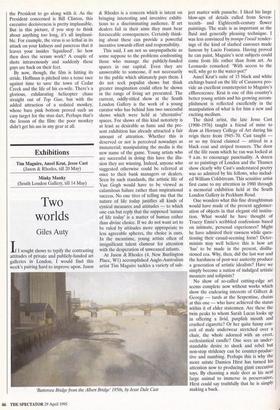Exhibitions
Tim Maguire, Ansel Krut, Jesse Cast (Jason & Rhodes, till 20 May) Minky Manky (South London Gallery, till 14 May)
Two worlds
Giles Auty
If I sought shows to typify the contrasting attitudes of private and publicly-funded art galleries in London, I would find this week's pairing hard to improve upon. Jason & Rhodes is a concern which is intent on bringing interesting and inventive exhibi- tions to a discriminating audience. If art dealers fail in their aims they must bear foreseeable consequences. Certainly think- ing about these can provide a powerful incentive towards effort and responsibility.
This said, I am not so unsympathetic as some suppose to the problems confronting those who manage the publicly-funded spaces in our capital. Even they are answerable to someone, if not necessarily to the public which ultimately pays them. I do not seek populist shows but think greater imagination could often be shown in the range of living art presented. The current, oddly-titled show at the South London Gallery is the work of a young curator who has behind him two successful shows which were held at 'alternative' spaces. For shows of this kind notoriety is at least as desirable as fame and the pre- sent exhibition has already attracted a fair amount of attention. Whether this is deserved or not is perceived nowadays as immaterial; manipulating the media is the new name of the game. Young artists who are successful in doing this have the illu- sion they are winning. Indeed, anyone who suggested otherwise could be referred at once to their bank managers or dealers. Seen by such standards, the artistic life of Van Gogh would have to be viewed as calamitous failure rather than inspirational success. No one tires of telling me that the nature of life today justifies all kinds of cynical measures and attitudes — to which one can but reply that the supposed 'nature of life today' is a matter of human rather than divine choice. If we do not want art to be ruled by attitudes more appropriate to less agreeable spheres, the choice is ours. In the meantime, young artists often of insignificant talent clamour for attention with the desperation of unweaned infants.
At Jason & Rhodes (4, New Burlington Place, W1) accomplished Anglo-Australian artist Tim Maguire tackles a variety of sub- 'Battersea Bridge from the Albert Bridge' 1950s, by Jesse Dale Cast ject matter with panache. I liked his large blow-ups of details culled from Seven- teenth- and Eighteenth-century flower paintings. The scale is as important as the fluid and generally pleasing technique. I was less convinced by trompe l'oeuil render- ings of the kind of slashed canvases made famous by Lucio Fontana. Having proved he can paint, Maguire's next subjects could come from life rather than from art. As Leonardo remarked: 'With access to the well, why go to the water-pot?'
Ansel Krut's suite of 15 black and white etchings based on the life of Casanova pro- vide an excellent counterpoint to Maguire's efflorescence. Krut is one of this country's better young artists and his growing accom- plishment is reflected excellently in the manipulation of what is for him a new and exciting medium.
The third artist, the late Jesse Cast (1900-1976) taught a friend of mine to draw at Hornsey College of Art during his reign there from 1945-70. Cast taught or so my friend claimed — attired in a black coat and striped trousers. The door of the life room which he ran was locked at 9 a.m. to encourage punctuality. A dozen or so paintings of London and the Thames show clearly why Cast's understated poetry was so admired by his fellows, who includ- ed William Coldstream. This sensitive artist first came to my attention in 1980 through a memorial exhibition held at the South London Gallery in Peckham Road.
One wonders what this fine draughtsman would have made of the present agglomer- ation of objects in that elegant old institu- tion. What would he have thought of Tracey Emin's scribbled confessions based on intimate, personal experiences? Might he have admired their rawness while ques- tioning their casual-seeming form? Deter- minists may well believe this is how art `has' to be made in the present, disillu- sioned era. Why, then, did the last war and the harshness of post-war austerity produce a generation of artistic idealists? Have we simply become a nation of indulged artistic moaners and solipsists?
No show of so-called cutting-edge art seems complete now without works which show the endearing interests of Gilbert & George — turds at the Serpentine, chains at this one — who have achieved the status within it of elder statesmen. Are these the twin peaks to whom Sarah Lucas looks up in offering a livid, purplish mouth and crushed cigarette? Or her quite funny con- ceit of male underwear stretched over a chair, the whole adorned with an erect, ecclesiastical candle? One sees an under- standable desire to shock and rebel but non-stop stridency can be counter-produc- tive and numbing. Perhaps this is why the more astute Damien Hirst has turned his attention now to producing giant executive toys. By choosing a male deer as his next large animal to immerse in preservative, Hirst could say truthfully that he is simplY making a buck.


























































 Previous page
Previous page